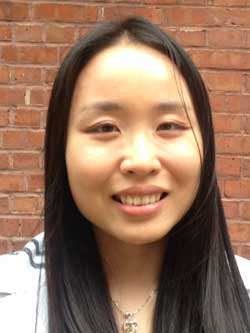Filed Under > Convocation
Na Li: Modeling changing in order to help make it
Na Li: Modeling changing in order to help make it
How did Li, who says she received little support from her teachers, go on to not merely succeed but become a passionate learner of science, math and technology?
Part of the story was Li’s own persistence and determination to face challenges head on. Part remains a mystery –a product of the broader web of variables – intelligence, curriculum, family, experience – that shapes us all.
Unraveling such mysteries has been the focus of Li’s work at Teachers College, a place she calls her “dream come true.” For her doctoral dissertation, Lee worked with John Black, Cleveland E. Dodge Professor of Telecommunications & Education, to design computerized simulations with a flash player to teach the idea of complex systems to middle school students. Complex systems, such as rain forests, municipal economies, or the human digestive tract, comprise many different but inter-dependent components. A change in one component, such as temperature, can send ripples across an entire system.
In biological systems, computer simulations can often explicate change at the molecular or cellular level that is invisible to the naked eye. In any medium, simulations enable students to manipulate one component in the system and see how that change affects the whole. For example, by moving a mouse or tapping a key, a learner using Li’s prototype can simulate turning up a fire beneath an aerosol can. Moving pictures powered by the flash player show the molecules inside the can getting larger, moving faster, bumping into one another and against the inside of the can, ultimately causing it to explode. The student immediately understands the relationships between heat, molecular movement and size, and air pressure.
Beyond simulating experiences that would be unsafe outside a virtual realm, Li’s program uses “scaffolding” techniques that allow teachers to structure lessons that build on one another toward more sophisticated levels of inquiry. Some students might feel “cognitively overloaded” if asked to learn an entire system as a whole, Li says, but by scaffolding the learning tasks, teachers can “properly sequence learning activity and make connections between micro and macro.”
Li plans to spend five years doing post-doctoral research at an American university. Eventually she would like to return to China, where she hopes her work can make a difference in the lives of children who struggle in school as she did.
Published Friday, Jun. 7, 2013
